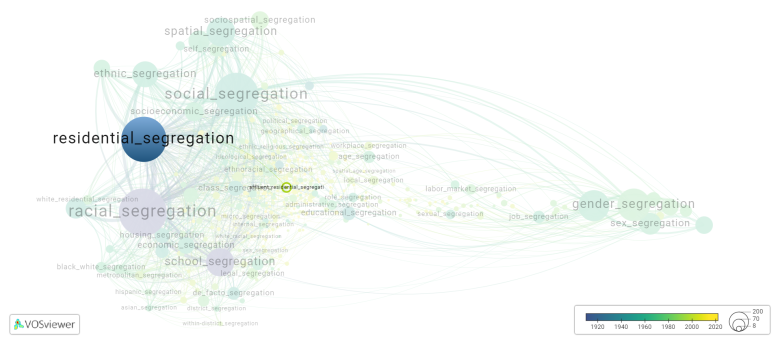Affluent residential segregation: Difference between revisions
(Creating page) |
(Creating page) |
||
| (10 intermediate revisions by the same user not shown) | |||
| Line 1: | Line 1: | ||
===== Date and country of first publication<ref>Date and country of first publication as informed by the Scopus database (December 2023).</ref>===== | |||
2007<br> | 2007<br> | ||
United States | |||
===== Definition ===== | |||
Affluent residential segregation refers to the phenomenon of affluent individuals or families concentrating in specific neighborhoods or communities, resulting in a segregation of wealth and resources. It is a form of residential segregation where higher-income households cluster together, often leading to disparities in education, access to amenities, and quality of life between affluent and lower-income areas. This segregation is often driven by factors such as economic inequality, racial or ethnic disparities, and housing market dynamics. Affluent residential segregation can perpetuate social and economic divides, reinforcing advantages for the affluent while limiting opportunities for those in less affluent areas. | Affluent residential segregation refers to the phenomenon of affluent individuals or families concentrating in specific neighborhoods or communities, resulting in a segregation of wealth and resources. It is a form of residential segregation where higher-income households cluster together, often leading to disparities in education, access to amenities, and quality of life between affluent and lower-income areas. This segregation is often driven by factors such as economic inequality, racial or ethnic disparities, and housing market dynamics. Affluent residential segregation can perpetuate social and economic divides, reinforcing advantages for the affluent while limiting opportunities for those in less affluent areas. | ||
==See also== | ==See also== | ||
==Related segregation forms== | |||
Affluent residential segregation is frequently discussed in the literature with the following segregation forms: | |||
[[residential segregation]] | |||
[[File:affluent_residential_segregation.png|780x780px]] | |||
This visualization is based on the study [[Segregation_Wiki:About| The Multidisciplinary Landscape of Segregation Research]]. | |||
For the complete network of interrelated segregation forms, please refer to: | |||
* [https://tinyurl.com/2235lkhw First year of publication] | |||
* [https://tinyurl.com/2d8wg5n3 Louvain clusters] | |||
* [https://tinyurl.com/223udk5r Betweenness centrality] | |||
* [https://tinyurl.com/244d8unz Disciplines in which segregation forms first emerged (Scopus database).] | |||
==References== | ==References== | ||
==Notes== | ==Notes== | ||
<references /> | <references /> | ||
== | {{NoteAI}} | ||
==Affluent residential segregation appears in the following literature== | |||
Dwyer R.E. (2007) | Dwyer R.E. (2007). Expanding homes and increasing inequalities: U.S. housing development and the residential segregation of the affluent. ''Social Problems'', ''54''(1), 23-46. https://doi.org/10.1525/sp.2007.54.1.23 | ||
Latest revision as of 07:17, 16 October 2024
Date and country of first publication[1][edit | edit source]
2007
United States
Definition[edit | edit source]
Affluent residential segregation refers to the phenomenon of affluent individuals or families concentrating in specific neighborhoods or communities, resulting in a segregation of wealth and resources. It is a form of residential segregation where higher-income households cluster together, often leading to disparities in education, access to amenities, and quality of life between affluent and lower-income areas. This segregation is often driven by factors such as economic inequality, racial or ethnic disparities, and housing market dynamics. Affluent residential segregation can perpetuate social and economic divides, reinforcing advantages for the affluent while limiting opportunities for those in less affluent areas.
See also[edit | edit source]
Related segregation forms[edit | edit source]
Affluent residential segregation is frequently discussed in the literature with the following segregation forms:
This visualization is based on the study The Multidisciplinary Landscape of Segregation Research.
For the complete network of interrelated segregation forms, please refer to:
References[edit | edit source]
Notes[edit | edit source]
- ↑ Date and country of first publication as informed by the Scopus database (December 2023).
At its current state, this definition has been generated by a Large Language Model (LLM) so far without review by an independent researcher or a member of the curating team of segregation experts that keep the Segregation Wiki online. While we strive for accuracy, we cannot guarantee its reliability, completeness and timeliness. Please use this content with caution and verify information as needed. Also, feel free to improve on the definition as you see fit, including the use of references and other informational resources. We value your input in enhancing the quality and accuracy of the definitions of segregation forms collectively offered in the Segregation Wiki ©.
Affluent residential segregation appears in the following literature[edit | edit source]
Dwyer R.E. (2007). Expanding homes and increasing inequalities: U.S. housing development and the residential segregation of the affluent. Social Problems, 54(1), 23-46. https://doi.org/10.1525/sp.2007.54.1.23

